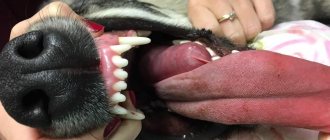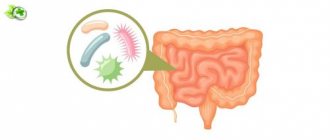The essence of the gag reflex and common causes of vomiting
Vomiting in a dog
The gag reflex refers to the protective properties of the body, in which the evacuation of food debris and suspected toxins occurs. Vomiting is an involuntary action, the root causes of its occurrence include:
- food, drug, etc. poisoning;
- helminthiasis;
- allergies and infectious diseases;
- penetration of insects into the lungs;
- stress, overeating;
- overheating in the sun, etc.
Important! The animal may experience diarrhea or constipation. The pet often licks its lips, is restless, may suffer from increased gas formation, and regurgitate recently eaten food.
Causes of poor condition
Prevention of hematemesis in animals
Clinically healthy animals with strong immunity are less susceptible to the development of hematemesis (bloody vomiting) and the causes that cause it. The key to this is a healthy, nutritious diet, proper care, maintenance and proper physical activity depending on the breed of your dog.
Meals should be regular and preferably on a schedule at the same time. Don't skip vaccinations, especially if you have a puppy. Deworm regularly. Prohibit dogs from picking up anything on the street to avoid poisoning. Do not feed bones with sharp edges, large bone fragments, etc.
If dogs have health problems, then try not to let the illnesses become chronic, as this will make the dog very weak and be predisposed to hematemesis. Regularly use vitamins, nutritional supplements, vitamin complexes during the period of possible vitamin deficiency. Use high-quality raw materials for nutrition and only good, licensed feed. Make sure that the puppy does not swallow a foreign body!
Varieties of vomit by color and consistency
The color of vomit helps to roughly determine the reasons for its occurrence.
Dog vomiting is yellow
If a dog is vomiting yellow liquid (orange), then it contains bile. Sources of discomfort are presented:
- chronic gastrointestinal pathologies - gastritis or ulcers;
- cholecystitis;
- viral or infectious hepatitis;
- helminthiasis;
- piroplasmosis;
- a tumor localized near the gallbladder;
- overeating.
Repeated occurrence of vomiting requires a visit to the veterinarian and a full diagnostic examination.
With a pinkish tint
A pink mass indicates the presence of an infectious disease, including trancheobronchitis. Damage to the upper respiratory tract is accompanied by a dry cough and fever. Pathologies pose a particular danger to puppies.
Important! If the contents are bloody with pink streaks, the root cause may be helminthic infestations and infections. Bright scarlet clots raise suspicions of injuries to the nasopharynx, oral cavity, chest or larynx.
With green color
Vegetable shades occur when the contents of the small intestine enter the stomach. The problem is associated with obstruction, helminths, and certain infections. In the summer, green vomit occurs when your pet consumes excessive grass.
Foam type
If your dog is vomiting yellow with white foam, it may be a defensive reaction. An animal may vomit when it is hungry or overeating. Regular repetitions should alert the owner of the four-legged dog - the development of gastrointestinal diseases is possible.
Important! If the dog vomits yellow foam and at the same time suffers from diarrhea, then there is a risk of poisoning or a viral infection.
In addition to loose stools with a distinct odor, the pet may experience a decrease in appetite or refusal to eat, lethargy, weakness, and fever.
Infectious lesion
Why does a dog vomit bile?
If the foam acquires a yellowish tint and occurs regardless of food intake, this may indicate a dangerous disease. In addition, often vomiting with bile may indicate the presence of a foreign body in the animal’s stomach. If you find a small object in the vomit, you should not worry: the dog’s body itself got rid of this trouble.
Below are cases of vomiting that signal pathology in your pet's body.
- Constant vomiting with bile, which is accompanied by poor health of the animal (the dog may refuse to eat, be less active). This condition is accompanied by elevated body temperature and stool disorders. In this case, the dog may sit with its front legs widely spaced, which indicates a painful abdomen. These symptoms may be a sign of viral or infectious hepatitis.
- Gastritis in the chronic stage is also accompanied by constant yellow vomiting, most often this phenomenon is observed in the morning. However, in contrast to ordinary physiological vomiting on an empty stomach, when the dog still remains cheerful, with gastritis the animal rapidly loses weight, its appetite worsens and apathy appears. This condition can last for more than one week, while the animal weakens every day, the condition of the coat also worsens, it becomes dull and matted.
- Another reason for vomiting with bile is the presence of parasites in the body. This pathology provokes intoxication; the body tries to get rid of signs of poisoning by vomiting. Remember: a large number of worms in the body of a dog, especially a puppy, can lead to the death of the pet. Worms can be found both in vomit and in feces, and helminthic infestation is accompanied not only by vomiting, but also by exhaustion of the animal.
- A peptic ulcer or tumor in the stomach also contributes to vomiting. In this case, the dog vomits after eating undigested food, but in some cases this phenomenon is observed before eating. Symptoms require immediate contact with a veterinarian and ultrasound diagnostics.
- Piroplasmosis is a dangerous pathology in which the animal can die within a few days after its development. The main danger is that on the first day of the disease there are no obvious symptoms, and vomiting begins already at the terminal stage.
Causes of bilious vomiting in dogs
There are two large subgroups of sources that cause bile vomiting in dogs.
Physiological or non-hazardous factors
If the reflex is a one-time occurrence and there are no changes in usual behavior, there is no need to worry. This triggered a standard defense mechanism that protects the body from poisoning. Conditions that cause dogs to burp can be caused by:
- overeating - when feeding heavy food in large quantities;
- grass - greens can become a stimulant of the gag reflex and cause a natural cleansing of the gastrointestinal tract;
- seasickness - animals become victims of trips by private car or public transport;
- vaccination - each organism has its own reaction to injected drugs, vomiting is one of the adverse reactions;
- anesthesia - the postoperative period provokes attacks of nausea and vomiting;
- lactation - physiological cleansing of the gastrointestinal tract is observed in some cases in lactating females;
- toxicosis - occurs in pregnant bitches in the early stages;
- diet - switching to industrial food from natural food or purchasing a new form of food;
- long fasting.
These reasons can be determined independently; they do not require contacting a veterinarian. The exception is cases when attacks continue for several days in a row - the pet needs help by taking it to the clinic.
Pathological preconditions
Conditions in which dogs vomit yellow foam may be associated with impaired functionality of internal organs. In addition to nausea and gastrointestinal dysfunction, the animal may experience apathy, loss of appetite (with complete or partial refusal to eat), and fever.
Why does my dog's stomach growl, diarrhea, cough and fever appear? Sources include:
- diseases of viral-bacterial origin;
- chronic pathologies of the digestive tract of any stage and severity;
- allergies, cancer;
- injuries of the gastrointestinal tract, larynx, nasopharynx, lungs;
- poisoning with toxic substances and foreign objects entering the respiratory tract;
- CNS lesions;
- diseases of the cardiovascular and respiratory systems, kidneys, and liver.
Important! If flatulence appears, accompanied by rumbling in the stomach, diarrhea, cough, or high temperature, the dog should be urgently taken to a veterinary clinic.
Non-pathological vomiting
Why does my dog vomit white foam and mucus?
White vomit in an animal in the morning may indicate that the dog has an empty stomach and urgently needs breakfast. After breakfast, food passes through the intestines within a few hours. In this case, the dog’s stomach remains empty, but there is gastric juice in it, and mucus forms on the walls of the organ. The main function of such a mucous substance is to protect the stomach from increased acidity of gastric juice. If, when eating, a dog actively swallows pieces, air enters the stomach, which, combined with mucus, forms foam.
That is why, if a dog vomits white foam, in most cases this is a normal physiological phenomenon that does not require contacting a specialist. At the same time, the animal’s health should be normal, the same applies to appetite. If vomiting occurs several times a week, it would be a good idea to visit a doctor who will conduct diagnostics to identify diseases of the digestive system.
Another case that does not require treatment is when a dog eats grass and then vomits. In this way, animals independently get rid of the remaining fur in the stomach, excess bile and other foreign objects. Eating grass is most often observed during a walk, and this phenomenon occurs infrequently (several times a month). Animals should not be driven away from plants. If a dog eats grass every time he goes outside, followed by vomiting, this may indicate excess bile in the stomach. In this case, you need to contact a specialist who will adjust the diet and possibly prescribe drugs with a choleretic effect.
What does this symptom mean?
Owners of four-legged animals need to learn to distinguish regurgitation from the gag reflex. The animal can vomit once; the excreted masses do not have a disgusting odor and do not include particles of blood or mucus. They contain undigested food residues.
The pathological type of vomiting is manifested by a pungent odor and is associated with cleansing not only the stomach, but also the intestines. The body calls it to remove toxic or solid substances.
Attention! If it is impossible to independently determine the source of the problem, you should immediately show the animal to a doctor and treat it.
Treatment of gastritis in dogs
Immediate treatment for severe symptoms of gastritis in dogs includes:
- rehydration;
- restoration of electrolytes with intravenous fluid.
The veterinarian may also prescribe antibiotics to treat the bacterial infection and antiemetics.
Treatment of gastritis at home:
- Regardless of what type of illness you are treating, it is correct to put your pet on a fasting diet for 24-48 hours, during which time he should have only clean water.
- If your dog is not vomiting within 24 hours, begin feeding small amounts of soft food at frequent intervals. The diet should contain only low-fat foods.
- Gradually increase the amount of food over the following days.
- If vomiting returns, avoid all foods and call your veterinarian.
Chronic gastritis in a dog will be treated depending on the cause of the inflammation. If the condition is unstable, hospitalization with intravenous fluids and antiemetics may be required.
It is very important to treat the root cause of gastritis:
- If it is due to poor nutrition, then simply take measures to prevent this from happening again.
- If the reason is that the dog has swallowed a foreign object, then surgery may be necessary to remove it from the stomach.
- In the case where the cause is an allergy, you need to remove the allergen from the dog’s environment. Antihistamines or other drug treatments may be needed.
- Kidney disease, stomach cancer, immune diseases and neurological disorders must be considered separately. A special course of treatment is prescribed for them.
Did you know? It is estimated that 30% of Dalmatians are deaf in one ear, and 5% of these dogs are born deaf in both ears. In Dalmatians with large spots, this defect is less common than in others.
If a dog often suffers from gastritis, then you need to remember what it eats at home, how it reacts to certain substances, and what preceded the period of exacerbation. Be sure to discuss this with your veterinarian. You may need to make adjustments to your feeding diet or daily routine.
Drugs
The first purpose will be to restore the level of electrolytes in the blood and restore water balance. In this case, intravenous fluids are administered. Antibiotics are needed if there are signs of infection. Antiemetic drugs are given until vomiting stops.
| Group of drugs | Name | Dosage and features of administration |
| Fluid therapy | "Isotonic solution" (saline solution) | Prescribed to restore water balance in case of moderate dehydration of the body. Administered by drip. The dosage depends on the dog's body weight. |
| Antiemetics | "Metoclopramide" | 0.3 mg/kg, three times daily or 1-2 mg/kg/day as a constant rate infusion. The drug enhances intestinal motility. |
| "Maropitant" | 1 mg/kg/day for 5 days. | |
| "Ondansetron" | 0.1–1 mg/kg once or twice daily. | |
| Gastroprotectors | "Famotidine" | 0.5–1 mg/kg. The drug is intended to protect the mucous membrane from the effects of irritants, including gastric juice. |
| "Almagel" | 0.5–1 scoop 3 times a day before meals. | |
| Proton pump inhibitors | "Omeprazole" | 0.7–2 mg/kg/day. The drug suppresses stomach acid. |
| "Pantoprazole" | 1 mg/kg/day. |
Important points in treatment:
- Use only those medications prescribed by your doctor.
- Carefully monitor changes in your pet’s condition and be sure to monitor the results a month after completing the course.
- If a diet is prescribed, do not offer the caudate patient other foods.
- Make sure your pet always has enough drinking water.
- If an infectious disease is diagnosed, isolate the dog from other pets during treatment. Wash your hands after handling animals to reduce the chance of transmitting infection.
If there is no improvement within 2 days after starting treatment, the veterinarian may reconsider the course and prescribe another treatment
Diet
Basic rules for preparing a diet:
- Meat remains the most important part of the diet, especially if we are talking about a puppy. For gastritis, it is not excluded from the menu, but low-fat varieties of chicken, chicken liver, and turkey are chosen. Meat is a very important source of nutrients.
- Proteins should be easily digestible. Usually we are talking about eggs, low-fat cheese, tofu (bean curd).
- They give white boiled rice without spices. Boil it as usual and then mix it with protein. A pet's meal may include 1-2 teaspoons of protein food and 200 g of rice.
- Yogurts are sometimes supplemented with protein, but flavored yogurt may contribute to diarrhea.
- Boiled potatoes and pasta are allowed into the diet.
Important! Basic rule: only 1 carbohydrate and 1 type of protein per feeding. Do not mix different types of food, because when gastritis worsens, the body cannot cope with them.
Physiotherapy
Physiotherapeutic procedures are aimed at:
- for pain relief;
- stimulation of mucosal regeneration.
They are recommended for chronic gastritis.
The methods used will be as follows:
- electrophoresis;
- laser (magnetic laser) therapy;
- balneotherapy (baths, drinking mineral waters);
- ultrasound therapy (for pathologies with preserved and increased secretion);
- influence of diadynamic currents;
- inductothermy (for gastritis with reduced secretion).
The choice of method depends on the capabilities of the clinic. They can also be used at home if the appropriate equipment is available. For example, an electrophoresis apparatus may well be purchased for individual use.
Available for sale:
- nevoton "Elfor" or "Elflor Plus";
- galvanizer "Potok-1".
The device supplies current to metal plates wrapped in cloth containing a medicinal solution. Thus, under the influence of current, the medicine breaks down into ions, which penetrate the skin and have a therapeutic effect. The convenience of electrophoresis is that the drug is supplied in active form, in the right place, does not cause addiction, pain and does not give side effects.
Portable devices for magnetic laser therapy are also available for sale in a sufficient range:
- "Knight";
- "Orion";
- "Milta."
You will be interested to know the causes of hearing loss in dogs and the treatment of deafness.
All of them affect the diseased organ with electromagnetic radiation. This reduces inflammation, activates blood circulation, relieves pain and has an anti-edematous effect. When treating with physiotherapeutic methods, it is important to follow the doctor's recommendations. For example, electrophoresis is prescribed 2 times a day - morning and evening, but the frequency of the current during the sessions is different. Only a specialist can establish the required norm, taking into account the parameters of the dog and the severity of the disease.
How to treat the chronic form
Treatment of chronic gastritis is based on:
- on identifying and treating major metabolic disorders;
- removing toxins, foreign bodies, parasites and fungal infections from the body.
Gastritis of parasitic origin is treated with Fenbendazole at a dose of 10 mg/kg for 2 days. Helicobacter-associated gastritis is treated with a combination of Amoxicillin (20 mg/kg 2 times a day), Clarithromycin (7.5 mg/kg 2 times a day) and Metronidazole (10 mg/kg 2 times a day) in within 14 days.
Treatment is necessarily accompanied by a diet. To eliminate the possibility of an allergic reaction, it is recommended to replace your pet’s usual proteins with others, for example, chicken and beef with hydrolyzed proteins (soy). You need to stick to the diet for 2 weeks. If the vomiting has disappeared, then gradually begin to introduce the dog’s usual diet. If this symptom remains, then treatment and diet are extended for the next 2 weeks.
Important! Some people believe
that water helps treat gastritis, but this is not true. The body needs water to maintain balance, but too much can change stomach acidity and worsen symptoms. Therefore, if your pet does not want to drink, do not insist, just make sure that he has water in his bowl.
Emergency help at home
When symptoms appear, in which the dog vomits yellow liquid along with foam, the owner must provide first aid to the four-legged dog. The procedure is performed until an accurate diagnosis is established and does not cause harm to health. Proceeds according to the following algorithm:
- The owner should not show his own excitement - from the moment of the attack he will have to monitor the pet’s condition, remembering all the clinical signs of ill health.
- The dog must be reassured - he must be sure of his safety. You shouldn’t speak in a raised voice, panic, or think about what to do with him.
- The animal is stopped feeding and water is given in unlimited quantities. To suppress repeated vomiting, you can offer him ice cubes.
Keep the pet hungry until the reasons for the deviation are determined. The zero table lasts 24 hours, he must have free access to clean water. If the issue is related to physiological manifestations, then for the next two days the dog is fed dietary food, and later returns to the usual menu.
Important! If you suspect a pathological origin of vomiting in a Spitz in the morning, you should not engage in amateur activities and give medications.
How to give water to a sick animal
What to do when your dog is vomiting when hungry
- Have a regular feeding schedule and follow it as closely as possible.
- From time to time, perhaps on weekends, add extra food to your diet. This could be another raw food, bone broth, a raw meaty bone, or a simple home cooked meal. Naturally, you will have to reduce the amount of your next meal.
- You can add a little more food before each meal to reduce hunger between meals.
- Increase the amount of fiber per meal because fiber keeps you feeling full longer.
Green beans or canned pumpkin are a great idea.
You should take hungry vomiting in the morning seriously. Over time, your dog's body will continue to respond by producing bile in the required quantities. As your dog gets older, you may notice that hunger vomiting occurs less frequently. This is not because she overcame the “problem”, but on the contrary, the stomach mucosa, as a protective mechanism, became tougher. It's not very good. To compensate, your dog's body will give up the sensitivity and vitality needed to keep its digestive system working efficiently. And since everything is connected to each other, the result can be other complications that may turn out to be much later in life.
© shutterstock
Diagnosis of bilious vomiting in dogs
The veterinary clinic conducts a full diagnostic examination. After treatment, the doctor does a general examination of the pet, measuring heart rate, temperature, and determining the condition of the mucous membranes.
The veterinarian makes a preliminary diagnosis and sends it for additional research:
- clinical urine and blood tests (fasting);
- X-ray and endoscopic examinations;
- Ultrasound of the abdominal cavity.
Important! After passing all the tests and studies, the specialist makes a final diagnosis and prescribes treatment in accordance with the complexity of the disease and the current condition.
Passing an ultrasound
Types of gastritis in dogs
Gastritis is an acute or chronic syndrome that causes vomiting and inflammation of the gastrointestinal tract. This disease can lead to gastrointestinal disorders with a fairly wide range of symptoms. The disease can be acute. In this case, symptoms occur suddenly and sharply. Or chronic, when they develop constantly and worsen over time. Accordingly, treatment and diet for these two conditions will be different.
Did you know? A wet nose helps your dog absorb odors better. For this purpose, it secretes special mucus.
If we divide gastritis in dogs according to the composition of the acidic environment in the gastrointestinal tract, we get the following disease:
- with an increased level of acidity;
- neutral.
Gastritis with high acidity is also called hyperacid. It is accompanied by severe pain. Hypoacid is a disease with low acidity, and anacid is a disease with zero acidity. This characteristic is often found in the description of chronic gastritis. Other forms of the disease:
| Type of gastritis | Reasons for appearance | Symptoms |
| Erosive (hemorrhagic) | It appears after a long course of drug treatment. | Ulcers on the mucous membrane that bleed; vomiting and bloody feces; acute pain in the gastrointestinal tract. |
| Eosinophilic | Unknown, but there are 2 points of view on the origin of the disease: frequent allergies and parasites. | Thickenings called eosinophils form on the mucosa. |
| Atrophic | Caused by bacteria or immune disorders. | The intestinal walls become thicker. |
| Lymphocytic | This is a reaction of the immune system to certain foods. | There is swelling and there is difficulty moving food through the esophagus. |
| Plasmacytic | Unknown. | The accumulation of leukocytes in the gastrointestinal tract manifests itself as chronic inflammation of the inner lining of the stomach. |
When you need to see a doctor urgently
The physiological origin of the ailment does not require the intervention of the owner; the deviation goes away on its own. A visit to the veterinary clinic is recommended if you have the following symptoms:
- if your pet continues to burp regularly;
- the appearance of streaks of blood, pus, mucus or their non-standard color in the vomit;
- frequent urination;
- change in color of the mucous membranes of the oral cavity - yellowness or whitish coating;
- weakness, lethargy, apathy;
- fever, cramps, soreness and bloating.
Important! Serious clinical manifestations of the pathology include sudden weight loss and complete refusal to eat.
Visit to the veterinarian
Treatment options
Based on the diagnostic results, the dog will be prescribed treatment. Before vomiting stops, the animal is placed in a hospital. Solutions are administered intravenously to maintain vital functions. As you recover, you will be prescribed a special diet that excludes gastrointestinal irritation and medications.
First aid for a pet
Before contacting a specialist, first aid for a dog is to completely stop feeding it. This will reduce the level of irritation of the gastrointestinal mucosa. Give water in small quantities, in small sips. If the visit to the doctor is delayed, you can give your dog Kvamatel to alleviate the condition.
If poison has entered the stomach, then within the first two hours you need to provide emergency assistance to your pet:
- introduce hydrogen peroxide at the rate of 1-2 ml/kg;
- give a subcutaneous injection of vitamin K1 (5 mg/kg, after 12 hours – 1 mg/kg);
- give sorbent.
Medications
After establishing an accurate diagnosis in the case of a gag reflex with blood, doctors usually prescribe a set of medications:
- antiemetics (Cerukal, Kvamatel);
- antispasmodics (Drotaverine, Papaverine);
- hemostatic agents (Vikasol, Dicynon);
- sorbents (Smecta, Enterosgel).
To eliminate the causes of vomiting, antibiotics, NSAIDs, and deworming medications can be prescribed. With the onset of remission, vitamins and homeopathy are prescribed to restore the weakened body.
What rabies vaccinations are given to dogs? Learn about the types of vaccines and the specifics of the procedure.
Photos of food allergies in dogs, rules and methods of treating the disease can be seen in this article.
On the page, look at the options for everyday, original and spectacular haircuts for Yorkie boys.
Folk remedies and nutrition
In some cases, folk remedies are used as adjuvant therapy. A decoction of flaxseed will help protect the stomach walls from irritation. When the vomiting goes away, you can give the animal a mint decoction. It relaxes the stomach muscles and helps prevent repeated vomiting. A decoction of dill seeds, lemon balm, and chamomile also helps with intestinal ailments.
After the vomiting stops, the dog must be put on a diet. Feed her in small portions.
Allowed to give:
- low-fat cottage cheese;
- liquid rice water;
- oatmeal;
- curdled milk.
First aid for an animal
Vomiting is not a disease, it is one of the signs of some kind of illness. Do not scold under any circumstances if the animal begins to vomit. The dog does not control its condition and cannot stop vomiting; it begins to vomit in order to empty its stomach, remove grass, hairballs or even toxic substances from the body.
The main task of the dog breeder is to calm the pet as much as possible and help him. If there is a collar around its neck, remove it to prevent your dog from choking on vomit.
Monitor the condition of the animal and remember the symptoms of the disease. It is recommended to pay attention to the color, thickness and composition of the vomit, remember the frequency of vomiting and side symptoms. The dog may become lethargic and sleepy, there is a sharp loss of strength, a change in body temperature, diarrhea, and possible discharge from the eyes, ears or nose. Pain and cramps that cause discomfort are accompanied by whining, barking or squealing from the dog.











